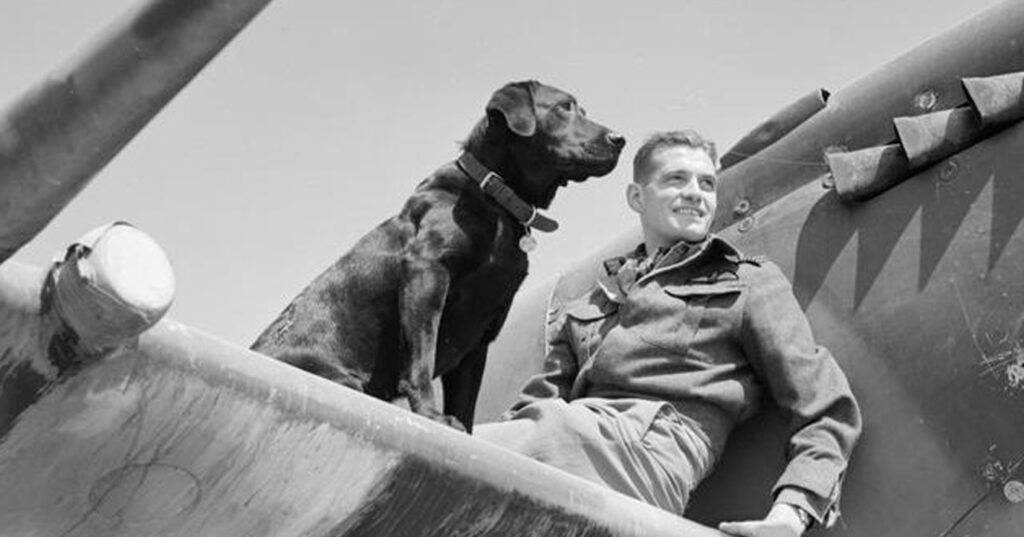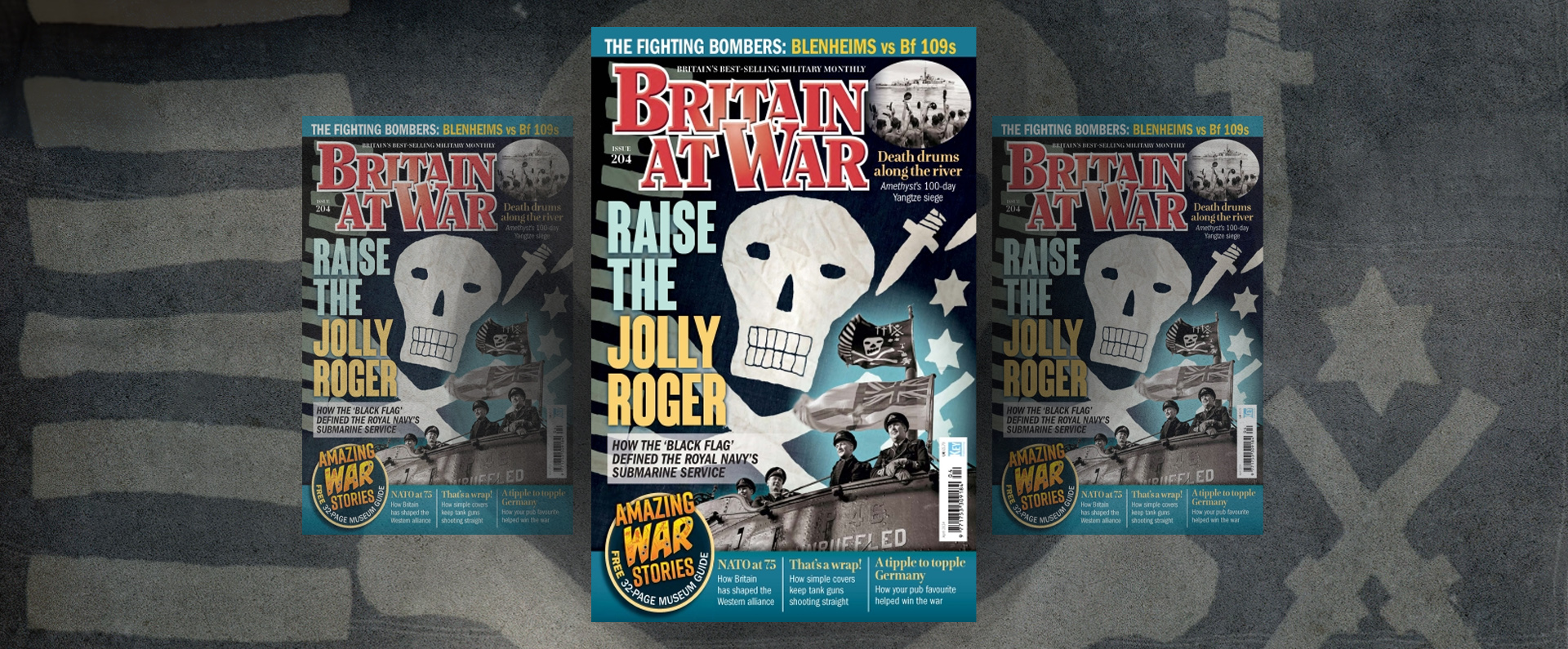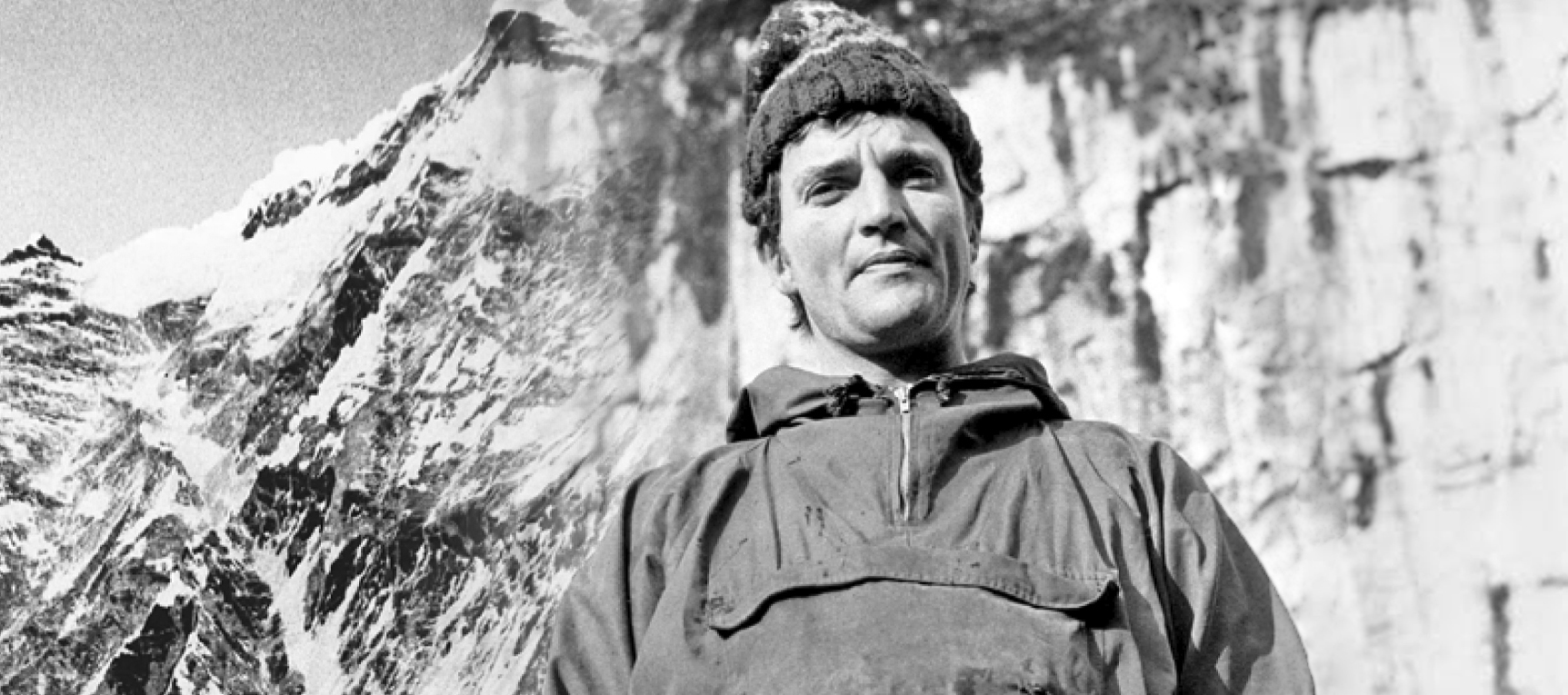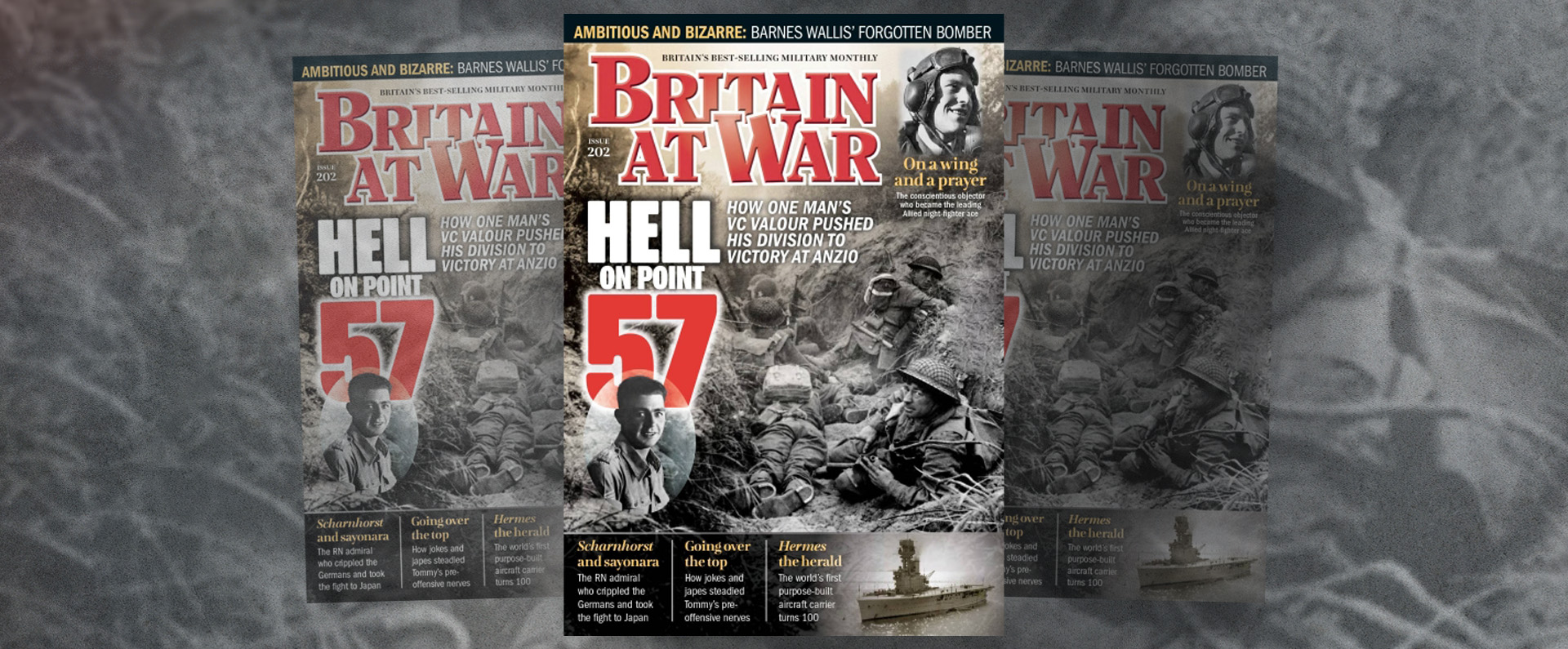
Published in Britain at War February 2014.
Air Vice Marshal James “Johnnie” Johnson CB CBE DSO & 2 Bars DFC & Bar
Against all the odds, “Johnnie” Johnson survived the Second World War as the highest-scoring RAF ace of the conflict. In the latest article in his “Hero of the Month” series, Lord Ashcroft tells the story of remarkable man who was also a great team player.
“Johnnie” Johnson not only flew in more than 700 Spitfire combat missions during the Second World War but he was also the top-scoring RAF flying ace of the conflict with thirty-eight confirmed victories. Furthermore, he was awarded a staggering three DSOs, and two DFCs as well as other decorations both from home and abroad. Unlike many top fighter pilots who preferred to concentrate on their own flying, Johnson was an inspirational leader of men and trained, encouraged and led scores of Allied pilots.
The son of a policeman, James Edgar Johnson was born on 9 March 1915 in Barrow upon Soar, Leicestershire, and educated at nearby Loughborough Grammar School. Later he attended Nottingham University, where he graduated as a qualified civil engineer in 1938. Despite starting flying lessons at his own expense, he applied unsuccessfully for the part-time Auxiliary Air Force (AAF). His second application to the AAF was also unsuccessful as was his initial application to the Royal Air Force Voluntary Reserve (RAFVR). As tensions mounted in Europe, Johnson enlisted in the Leicestershire Yeomanry cavalry. However, the RAFVR began to expand in early 1939 and his earlier application was reactivated.
In December 1940, after his flying career was interrupted by an aggravated rugby injury, Johnson returned to 616 Squadron based at RAF Kirton in Lindsey, Lincolnshire, joining ‘A’ Flight and often flying as Hugh “Cocky” Dundas’s wingman. In a combat with an enemy Dornier, Johnson initially fired too soon but he learnt from his mistake and played his part, along with Dundas, in damaging the aircraft during a further attack, sending it limping back to Holland. 616 Squadron was posted back to 11 Group in February 1941, joining 145 and 610 Spitfire Squadrons at RAF Tangmere, Sussex. The following month, the legendary Douglas Bader was appointed wing leader and he chose Johnson to fly alongside him.
In May and June 1941, 616 Squadron flew “Rhubarb” operations, the name originating from the low-level at which they were flown. Bader’s search for the perfect flying formation saw him adopt the “Finger Four” in which Johnson was largely responsible for protecting Dundas. This restricted Johnson’s personal score but on 26 June 1941 he achieved his first “kill” in a dogfight with a Messerschmitt. Johnson later wrote: “I was dead line astern of the Messerschmitt and hit him behind the cockpit with the eight machine-guns. As the range closed I contrived to spray the 109 with bullets and the Pilot half rolled on to his back and jettisoned his hood…I hammered him once more.”
When Johnson started flying regular sweeps – one of nine pilots chosen for the role (as opposed to flying point patrols or convoy duties) – his score soon escalated. Johnson destroyed two enemy aircraft on 6 and 14 July 1941, having already damaged one on 4 July. On 21 July, he claimed a shared “kill” but on the same day he lost his wingman, Sergeant Mabbett, a tragedy that affected him greatly. On 9 August, he was flying in an operation when Bader was shot out of the sky. Five days later the news arrived that Bader was a PoW. Johnson wanted to show the wing was still very much up for the fight, embellishing his Spitfire with the words: “BADER’S BUS COMPANY, STILL RUNNING”.
On 30 September 1941, his DFC was announced when his recommendation stated: “Pilot Officer Johnson has taken part in 46 sweeps over enemy territory. He has at all times by his cheerful courage been a great asset to the Squadron. He has the following enemy aircraft to his credit: 4.5 Destroyed, 2 Probables, 1.5 Damaged.” At the same time, Johnson was appointed as Commander of ‘B’ Flight. By now, the character of 616 Squadron was changing: there were many young, foreign pilots in its ranks and Johnson was the sole survivor from the 1940 pilots. The Bar to Johnson’s DFC was announced on 26 June 1942 when his recommendation concluded that he “has been an inspiration to the Pilots under his command, and his cheerful countenance at all times has done much to foster a high morale in the Squadron.”
Johnson was appointed to the command of 610 (County of Chester) Squadron, based at RAF Coltishall, Norfolk, in July 1942 and was given the rank of acting squadron leader. 610 Squadron was part of 12 Group, but Johnson wanted it to be part of 11 Group for the combat “season”. Initially, Johnson and the men under his command had to accept shipping reconnaissance and convoy patrols but then came the opportunity for them to make their mark: the Combined Service raid on Dieppe, codenamed “Operation Jubilee”. Early on 19 August, the Squadron took off to provide top cover for Nos 411 (Royal Canadian Air Force) and 486 (Royal New Zealand Air Force) Squadrons, which had been tasked with preventing enemy aircraft from attacking the Allied ground forces. For Johnson and others involved in the thick of the fighting, it was to be an unforgettable day of relentless and daring aerial combat action, which included what he later assessed was his hardest dog-fight of the war: “We sparred for about a minute and I tried my usual tactic of trying to turn inside the enemy, but after a couple of turns I was making no headway, and, in fact, he was gaining on me!” Eventually, both pilots lived to fight another day.
By early 1943, Johnson was due to be rested but, instead, he was promoted to wing commander and given command of the Kenley Wing (No 403 and 416 Royal Canadian Air Force), which were re-equipped with Spitfire 1Xs. At this stage, he also adopted the call sign “Greycap” and, despite expert advice that it would be safer to change it periodically, kept it for the rest of the war. As a wing commander, he took up the privilege of substituting the Spitfire’s three initials for his own “JE-J”, even though he was again warned that this would attract unwanted “attention” from the enemy.
Johnson’s DSO was announced on 4 June 1943 when his recommendation concluded: “He is an outstanding Wing Leader and in my opinion his leadership expressed in his cheerful, forceful personality is largely responsible for the high morale and success of the Kenley Wing. Wing Commander Johnson puts the success of his Wing first on all occasions.”
The Canadian pilots thrived under his leadership and, over that spring and summer, shot down more than 100 enemy aircraft on fourteen missions over North-West Europe. As a mark of their respect for their Wing Commander, Johnson complied with their request to sport “CANADA” shoulder-flashes.
The first Bar to Johnson’s DSO was announced on 24 September 1943 when his recommendation stated: “Since the citation of the award of the D.S.O. to this Officer on 17 May, he has completed 41 offensive sorties, during which he has personally destroyed a further 7.5 enemy aircraft while damaging another. During the same period the Wing under his leadership has destroyed 27, probably destroyed 3 and damaged 30. This is considered to be a magnificent effort for [a] two months period and is due in large part to the skilful leadership and relentless determination to engage the enemy displayed by this Wing Leader.” In September, Johnson was also ordered off operations to a staff job at Uxbridge, north-west London. Here he worked with the USA Air Force co-ordinating escorts but he continued to “keep his eye in” by occasionally flying with Spitfire 1X and X11 combat units.
March 1944 saw Johnson appointed wing commander flying of 144 Wing, which comprised of 441, 442 and 443 Squadrons, Royal Canadian Air Force. By now, with twenty-five official victories, his score was closing in on the record total of “Sailor” Malan, who was no longer flying operationally. On 5 June 1944, the day before the D-Day landings, his Wing was instructed to protect part to the invading force’s eastern flank from air attack. On D-Day itself, Johnson led his men on several sorties over the invasion beaches.
Johnson’s second Bar to his DSO was announced on 7 July 1944 when his recommendation described him as “a leader who combines the complete confidence and respect of his Pilots, combined with an untiring patience and energy on his part.”
By 23 August 1944, his official tally had drawn equal with Malan’s thirty-two “kills”. He destroyed two more Bf 109s on 5 July and was feted by the Press. With typical generosity, Johnson suggested Malan’s achievement were superior since he had flown from 1940-1 when he had less protection in the air and was frequently outnumbered by the enemy. By now Johnson, and his faithful Labrador, Sally, were enjoying great public acclaim.
On 27 September 1944, Johnson collected his final victory, shooting down a Bf 109 at Rees on Rhine. In March 1945, he was promoted to group captain and was also given the command of 125 Wing that had been equipped with new Spitfire Mk IVs. Johnson’s verdict on the aircraft was it was a “nice, fast flying machine…but it’s not a Spitfire any more.”
Before and after the end of hostilities, Johnson was given numerous decorations by other Allied countries. He was awarded the American DFC on 18 January 1944, as well as the Belgian Order of Leopold and Croix de Guerre in January 1947. After the war, Johnson was given the task of organising a victory show over Denmark. He then continued to serve in Germany until 1946 before serving in Canada and the US, and completing a three-month tour of active service in the Korean War.
The 1950s saw him become an author too: in 1956 he published his autobiography Wing Leader. The 1960s saw more promotions: to air commodore in 1960 and to air vice marshal in 1963 when he was posted to Aden as Air Officer Commanding (AOC) Air Forces Middle East. Furthermore, Johnson was awarded the Companion of the Order of the Bath (CB) in June 1965, on top of his earlier Commander of the British Empire (CBE) announced on New Year’s Day 1960. Johnson retired in 1966 and, afterwards, worked for British, Canadian and South African companies, as well as founding the Johnnie Johnson Housing Trust to provide homes for thousands of elderly and disabled people. Johnson died from cancer on 30 January 2001, aged eight-five. I purchased his medals in December 2001 for a hammer price of £241,500, then the world record price for an RAF group at auction.
Download a PDF of the original Britain at War article
For more information, visit:
LordAshcroftOnBravery.com


